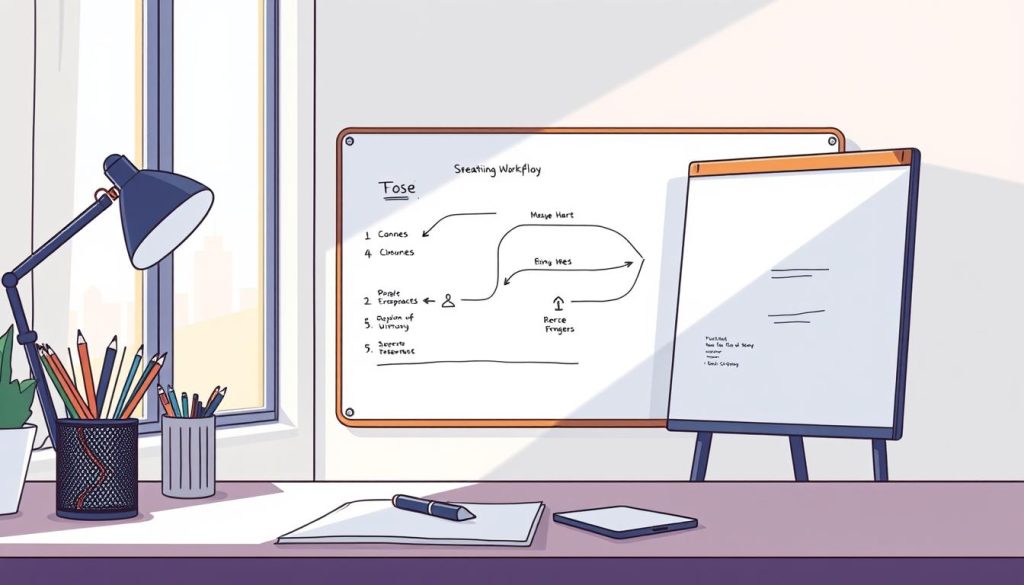What if streamlining your daily operations could unlock hours of productive time while strengthening your professional foundation? For independent professionals in France’s competitive market, this isn’t just a theory—it’s a career-defining opportunity.
Modern workflows often hide inefficiencies that drain resources and limit growth. By analyzing and refining how tasks are completed, you gain control over outcomes while reducing unnecessary effort. This approach isn’t about working harder—it’s about working smarter through strategic adjustments.
Our guidance focuses on practical methods to identify bottlenecks and redesign workflows. You’ll learn how successful businesses maintain agility without sacrificing quality, adapting strategies to fit solo ventures or small teams. These principles help stabilize income streams and create predictable results—critical factors for long-term independence.
Table of Contents
Key Takeaways
- Process optimization targets specific workflow improvements for maximum impact
- Eliminating redundant steps directly increases profitability and reduces stress
- Continuous refinement differs from general management by focusing on incremental gains
- Adapting corporate strategies benefits independent professionals through customized solutions
- Systematic analysis creates sustainable career security in fluctuating markets
Understanding Process Optimization
Transforming how you work starts with mastering principles that turn chaotic workflows into strategic assets. Unlike basic task management, this approach focuses on continuous refinement of existing systems—a necessity for professionals navigating France’s fast-paced market.
Definition and Importance
At its core, this methodology systematically enhances how tasks flow from start to finish. It’s not about overhauling everything overnight but making targeted adjustments that compound over time. For independent workers, this creates stability—your operations become resilient against sudden client demands or economic shifts.
Key Objectives and Expected Outcomes
The primary goals center on three pillars: financial efficiency, adaptability, and quality control. Reducing waste through streamlining internal operations directly boosts profitability, while flexible systems let you pivot services without downtime. Automation tools and workflow redesigns reclaim hours previously lost to repetitive tasks.
Error prevention acts as your safety net, ensuring consistent results that build client trust. When you align every action with clear objectives, you create a self-correcting framework that grows stronger with each project cycle.
The Role of Process Optimization in Business Success

How do thriving professionals in France consistently deliver results while managing unpredictable workloads? The answer lies in strategic workflow design—a game-changer for independent workers seeking stability in volatile markets. By aligning daily operations with clear objectives, you create systems that amplify effort rather than drain it.
Boosting Efficiency with Streamlined Workflows
Time-consuming tasks often hide opportunities for improvement. When you eliminate redundant steps in your business operations, you free up hours for high-impact work. A consultant who reduced client onboarding from 8 hours to 90 minutes shares:
« Simplifying paperwork let me focus on crafting tailored solutions—clients noticed the difference immediately. »
Streamlined methods also reduce decision fatigue. Automated reminders for invoices or standardized project templates ensure consistency without constant oversight. This reliability becomes your competitive edge when scaling services.
Enhancing Quality and Customer Satisfaction
Flawless execution builds trust faster than any marketing pitch. Refined workflows minimize errors through built-in checkpoints—like automated grammar checks for writers or double-verification steps for accountants. One graphic designer increased repeat clients by 40% after implementing quality assurance protocols.
Customers reward predictability. When deliverables arrive on time and exceed expectations, you become their go-to expert. This loyalty transforms short-term projects into long-term partnerships, fueling sustainable growth.
Steps for Streamlining Your Business Processes

Visualizing how work moves through your business uncovers hidden opportunities. Start by charting every action from project initiation to final delivery. This clarity transforms guesswork into actionable insights.
Mapping Current Workflows
Gather team members who handle tasks daily and those receiving outputs. Together, sketch each phase using flowcharts. Ask: « Does this step align with client expectations? » or « Where do delays typically occur? »
One marketing consultant discovered 23 redundant approval steps through this method. By simplifying communication channels, they cut project timelines by 35%. Visual diagrams expose mismatches between intended and actual practices.
Identifying Bottlenecks and Waste
Common issues emerge during analysis:
- Duplicate data entry across platforms
- Unnecessary document revisions
- Delays waiting for stakeholder feedback
A financial advisor reduced client onboarding errors by 62% after spotting inconsistent data collection methods. Regular workflow reviews prevent small inefficiencies from becoming costly habits.
Integrate these findings with strategic planning methods to prioritize changes. Focus first on areas causing client dissatisfaction or revenue leakage. Small adjustments create compounding time savings.
Advanced Process Optimization Strategies
Data transforms guesswork into actionable strategies for independent professionals. When harnessed effectively, metrics reveal hidden patterns that guide smarter decisions and fuel growth.
Leveraging Data and Analysis
Key performance indicators act as your business compass. A French printing company tracked order accuracy and discovered 80% of errors came from just five sources. By focusing on these root causes, they achieved 90% accuracy within six months.
Effective systems measure three elements:
- Output quality (errors per project)
- Time investments (hours per deliverable)
- Client feedback patterns
Setting Clear, Measurable Goals
Specific targets create accountability. Instead of « improve efficiency, » aim for « reduce revision requests by 30% in Q3. » This clarity helps prioritize actions that deliver real impact.
One consultant increased monthly revenue by 18% after setting specific, measurable targets for client retention. Regular progress checks maintained momentum while allowing course corrections. Performance tracking becomes your early warning system against inefficiency.
Establish benchmarks based on historical data, then challenge yourself to exceed them incrementally. This approach builds sustainable improvements without overwhelming your workflow.
Utilizing Process Mapping and Team Collaboration
Collaboration fuels innovation when refining how work gets done. For independent professionals in France, combining diverse perspectives helps uncover hidden inefficiencies that solo analysis might miss.
Assembling a Cross-Functional Team
Effective workflow improvements require input from all roles involved. Gather three key groups:
- Those executing daily tasks
- Individuals receiving outputs
- Decision-makers setting quality standards
A French translation agency improved project turnaround by 27% after including both linguists and client managers in their mapping sessions. This approach reveals how handoffs between roles create delays or errors.
| Role | Contribution | Common Insights |
|---|---|---|
| Task Executor | Identifies practical hurdles | Redundant steps, tool limitations |
| Output Recipient | Highlights quality gaps | Missing data, formatting issues |
| Management | Aligns with business goals | Cost vs benefit tradeoffs |
Defining Process Boundaries and Deliverables
Clear start/end points prevent scope creep. For a freelance consultant, this might mean:
- Starting when client signs contract
- Ending when final report gets archived
Common waste forms emerge during boundary setting:
- Repeated data entry (47% of workshops)
- Approval delays exceeding 48 hours
- Version control errors in documents
One Paris-based designer eliminated 12 hours/month of rework by standardizing file naming conventions across her team. Regular reviews maintain these improvements, ensuring your workflows stay aligned with evolving client needs.
Incorporating Lean, Six Sigma, and Kaizen Methodologies
Global efficiency strategies adapt remarkably well to independent professionals’ needs. These proven frameworks provide structured paths to eliminate waste and enhance service quality—critical for maintaining competitiveness in France’s freelance market.
Applying the PDCA Cycle
The Plan-Do-Check-Act method turns improvement into a habit. A freelance web developer used this approach to reduce client revision requests by 45% within three months. Start small: plan one workflow change, do a trial run, then check results before full implementation.
Deploying Six Sigma for Error Prevention
Six Sigma’s DMAIC framework (Define-Measure-Analyze-Improve-Control) targets recurring mistakes. One translator slashed formatting errors by 68% using measurement tools to identify root causes. This data-driven method builds reliability clients trust.
Combining these approaches with operational excellence strategies creates sustainable growth. Regular refinements keep your workflows aligned with market demands while preserving the agility that defines independent success.
FAQ
How does workflow analysis directly impact operational efficiency?
By examining task sequences and resource allocation, workflow analysis identifies redundancies and delays. This enables businesses to reduce cycle times by up to 30% while maintaining output quality through targeted improvements.
What metrics should companies track to measure optimization success?
Focus on lead time reduction, error rates, customer satisfaction scores, and resource utilization. Tools like Microsoft Power BI or Tableau help visualize these KPIs, aligning them with strategic objectives like cost control and service improvements.
Can small businesses benefit from methodologies like Six Sigma?
Absolutely. Six Sigma’s DMAIC framework (Define, Measure, Analyze, Improve, Control) helps organizations of all sizes reduce defects. For example, a 10-person marketing agency used it to cut client revision cycles by 40% through standardized approval workflows.
How do cross-functional teams accelerate process improvements?
Involving diverse roles – from frontline staff to IT specialists – surfaces hidden pain points. A SaaS company reduced onboarding delays by 25% after their support and engineering teams co-designed automated troubleshooting guides.
What’s the first step when mapping existing workflows?
Document each task’s inputs, outputs, and decision points using tools like Lucidchart. A logistics firm uncovered a 20-hour/week manual data entry bottleneck this way, which they later automated using Zapier integrations.
Why prioritize customer journey alignment in process redesign?
68% of clients switch providers due to poor service experiences. Aligning internal workflows with touchpoints – like using Zendesk for faster ticket resolution – boosts retention. One e-commerce brand saw 15% higher repeat sales after streamlining returns.





